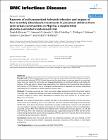| dc.contributor.author | JACKSON, ANDREW | en |
| dc.contributor.author | HOLLAND, CELIA | en |
| dc.contributor.author | MOLLOY, SILE | en |
| dc.date.accessioned | 2010-06-17T10:01:21Z | |
| dc.date.available | 2010-06-17T10:01:21Z | |
| dc.date.issued | 2009 | en |
| dc.date.submitted | 2009 | en |
| dc.identifier.citation | Kirwan, P., Asaolu, S.O., Molloy, S.F., Abiona, T.C., Jackson, A.L., Holland, C.V., Patterns of soil-transmitted helminth infection and impact of four-monthly albendazole treatments in preschool children from semi-urban communities in Nigeria: a double-blind placebo-controlled randomised trial., BMC Infectious Disease, 9, 20, 2009 | en |
| dc.identifier.other | Y | en |
| dc.identifier.uri | http://hdl.handle.net/2262/40169 | |
| dc.description | PUBLISHED | en |
| dc.description.abstract | BACKGROUND: Children aged between one and five years are particularly vulnerable to disease caused by soil-transmitted helminths (STH). Periodic deworming has been shown to improve growth, micronutrient status (iron and vitamin A), and motor and language development in preschool children and justifies the inclusion of this age group in deworming programmes. Our objectives were to describe the prevalence and intensity of STH infection and to investigate the effectiveness of repeated four-monthly albendazole treatments on STH infection in children aged one to four years. METHODS: The study was carried out in four semi-urban villages situated near Ile-Ife, Osun State, Nigeria. The study was a double-blind placebo-controlled randomised trial. Children aged one to four years were randomly assigned to receive either albendazole or placebo every four months for 12 months with a follow-up at 14 months. RESULTS: The results presented here revealed that 50% of the preschool children in these semi-urban communities were infected by one or more helminths, the most prevalent STH being Ascaris lumbricoides (47.6%). Our study demonstrated that repeated four-monthly anthelminthic treatments with albendazole were successful in reducing prevalence and intensity of A. lumbricoides infections. At the end of the follow-up period, 12% and 43% of the children were infected with A. lumbricoides and mean epg was 117 (S.E. 50) and 1740 (S.E. 291) in the treatment and placebo groups respectively compared to 45% and 45% of the children being infected with Ascaris and mean epg being 1095 (S.E. 237) and 1126 (S.E. 182) in the treatment and placebo group respectively at baseline. CONCLUSION: Results from this study show that the moderate prevalence and low intensity of STH infection in these preschool children necessitates systematic treatment of the children in child health programmes. | en |
| dc.language.iso | en | en |
| dc.relation.ispartofseries | BMC Infectious Disease | en |
| dc.relation.ispartofseries | 9 | en |
| dc.relation.ispartofseries | 20 | en |
| dc.rights | Y | en |
| dc.subject | Zoology | en |
| dc.subject | Soil-transmitted helminths | en |
| dc.title | Patterns of soil-transmitted helminth infection and impact of four-monthly albendazole treatments in preschool children from semi-urban communities in Nigeria: a double-blind placebo-controlled randomised trial. | en |
| dc.type | Journal Article | en |
| dc.type.supercollection | scholarly_publications | en |
| dc.type.supercollection | refereed_publications | en |
| dc.identifier.peoplefinderurl | http://people.tcd.ie/jacksoan | en |
| dc.identifier.peoplefinderurl | http://people.tcd.ie/cholland | en |
| dc.identifier.rssinternalid | 55439 | en |
| dc.identifier.doi | http://dx.doi.org/10.1186/1471-2334-9-20 | en |
| dc.subject.TCDTheme | Immunology, Inflammation & Infection | en |
| dc.subject.TCDTheme | Smart & Sustainable Planet | en |
| dc.identifier.rssuri | http://www.biomedcentral.com/1471-2334/9/20 | en |
| dc.identifier.orcid_id | 0000-0001-7334-0434 | en |
| dc.contributor.sponsor | Irish Research Council for Science and Engineering Technology (IRCSET) | en |




